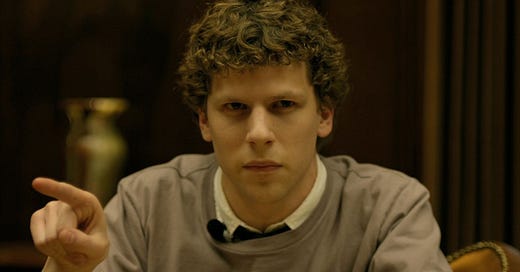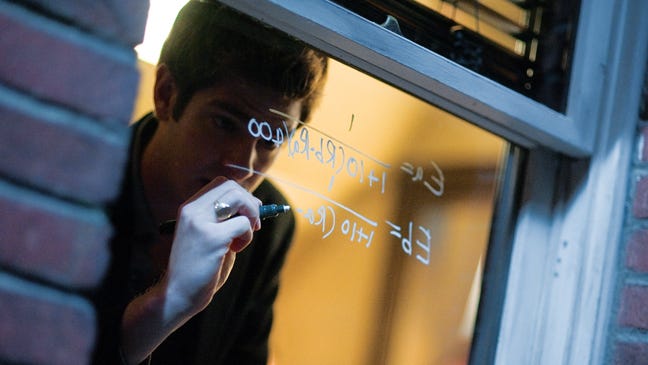by Jess Hagy
Director David Fincher is known for his many suspenseful drama films like Seven (1995) and Zodiac (2007), but one of his films, The Social Network (2009), doesn’t seem to fit into that film noir group...at least on the surface initially. With the aspects that qualify a film as noir, The Social Network checks many of those boxes. So, lets break down some of the list:
1. Cynical characters
One of the most common elements of film noir is their introverted and pessimistic characters, especially the protagonist. With The Social Network, almost all of the characters are cynical. The whole ten minute opening scene outlines Mark Zuckerberg and his pessimistic outlook, motivating him to then create Facebook. Jesse Eisenberg portrays Zuckerberg as an introverted intellect who looks down on others thinking he is smarter than them. This makes him an outcast among his peers.
2. Use of flashbacks
The way the film and screenplay are structured is to jump back and forth in time from present day and the past. The “present day” scenes take place in a few court cases where Zuckerberg is being sued. It then uses scenes, flashbacks if you will, that take place in the past giving context of the instances that were mentioned in the court cases.
3. Historical setting & intricate plot
This film is commonly categorized as a biographical drama, dating the setting of the story around the years that Facebook was first launched. This began while Zuckerberg was still a student at Harvard in 2004. The plot of the film becomes very complicated because of the many players that become involved in the development of the platform. The drama that unfolds centers around the legalities of who was actually involved and by how much which is very convoluted depending on who you side with.
4. Technical elements - deep focus camera shots & low-key lighting
David Fincher loves to use wide angles and shots to show the depth of space. This signature of his remains in The Social Network. The camera is frequently in deep focus as well as in muted lighting. The lighting is not flashy and very subtle. The three main tones color wise of the film are blue, brown, and tan/yellow. There are even some moments where Dutch angle shots are used which is also a noir staple. Here are some visual examples of the use of focus, angle, and lighting from the film:
5. Bleak overtones of despair/madness/isolation & underlying existentialism philosophy
The Social Network has a very bleak tone overall leading to the audience to feel like there is an ominous presence approaching. With this bleakness, the audience also infers the sadness and loneliness that the main character is going through. It feels like we are following Mark rise with his success with Facebook but also in turn spiral down into this silent depressive state and isolation.
The philosophy of existentialism explores the ideas relating to meaning, purpose, and human existence. A major theme of The Social Network is taking your life and putting it all online; having a whole existence there will add to and validate the meaning and purpose of everyday, regular life. The final shot of the film shows Zuckerberg sitting alone in a massive conference room. He is refreshing his Facebook page to see if someone from his past will accept his friend request. This depicts his ultimate loneliness by showing that he is more comfortable taking the risk and first step as his “online self” rather than his real active life.
There are so many more ways that make The Social Network film noir with the themes of greed, misogyny, power, etc - and even more technical aspects of sound and the use of dialogue. If I went through each minute detail then we’d be here forever and you’d end up reading a 40 page graduate thesis. So I will stop with these broad, main noir elements.






